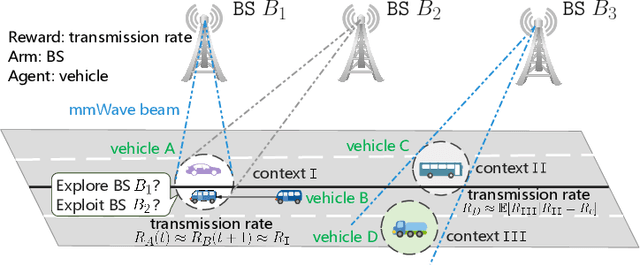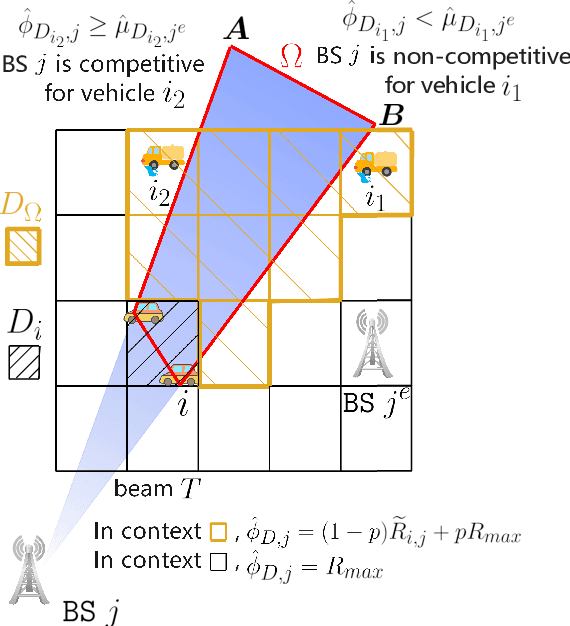Xiaoxia Huang
Learning-Based User Association for MmWave Vehicular Networks With Kernelized Contextual Bandits
Apr 15, 2025Abstract:Vehicles require timely channel conditions to determine the base station (BS) to communicate with, but it is costly to estimate the fast-fading mmWave channels frequently. Without additional channel estimations, the proposed Distributed Kernelized Upper Confidence Bound (DK-UCB) algorithm estimates the current instantaneous transmission rates utilizing past contexts, such as the vehicle's location and velocity, along with past instantaneous transmission rates. To capture the nonlinear mapping from a context to the instantaneous transmission rate, DK-UCB maps a context into the reproducing kernel Hilbert space (RKHS) where a linear mapping becomes observable. To improve estimation accuracy, we propose a novel kernel function in RKHS which incorporates the propagation characteristics of the mmWave signals. Moreover, DK-UCB encourages a vehicle to share necessary information when it has conducted significant explorations, which speeds up the learning process while maintaining affordable communication costs.
Contextual Bandits with Non-Stationary Correlated Rewards for User Association in MmWave Vehicular Networks
Oct 08, 2024



Abstract:Millimeter wave (mmWave) communication has emerged as a propelling technology in vehicular communication. Usually, an appropriate decision on user association requires timely channel information between vehicles and base stations (BSs), which is challenging given a fast-fading mmWave vehicular channel. In this paper, relying solely on learning transmission rate, we propose a low-complexity semi-distributed contextual correlated upper confidence bound (SD-CC-UCB) algorithm to establish an up-to-date user association without explicit measurement of channel state information (CSI). Under a contextual multi-arm bandits framework, SD-CC-UCB learns and predicts the transmission rate given the location and velocity of the vehicle, which can adequately capture the intricate channel condition for a prompt decision on user association. Further, SD-CC-UCB efficiently identifies the set of candidate BSs which probably support supreme transmission rate by leveraging the correlated distributions of transmission rates on different locations. To further refine the learning transmission rate over the link to candidate BSs, each vehicle deploys the Thompson Sampling algorithm by taking the interference among vehicles and handover overhead into consideration. Numerical results show that our proposed algorithm achieves the network throughput within 100%-103% of a benchmark algorithm which requires perfect instantaneous CSI, demonstrating the effectiveness of SD-CC-UCB in vehicular communications.
Optimal Resource Allocation for U-Shaped Parallel Split Learning
Aug 17, 2023



Abstract:Split learning (SL) has emerged as a promising approach for model training without revealing the raw data samples from the data owners. However, traditional SL inevitably leaks label privacy as the tail model (with the last layers) should be placed on the server. To overcome this limitation, one promising solution is to utilize U-shaped architecture to leave both early layers and last layers on the user side. In this paper, we develop a novel parallel U-shaped split learning and devise the optimal resource optimization scheme to improve the performance of edge networks. In the proposed framework, multiple users communicate with an edge server for SL. We analyze the end-to-end delay of each client during the training process and design an efficient resource allocation algorithm, called LSCRA, which finds the optimal computing resource allocation and split layers. Our experimental results show the effectiveness of LSCRA and that U-shaped PSL can achieve a similar performance with other SL baselines while preserving label privacy. Index Terms: U-shaped network, split learning, label privacy, resource allocation, 5G/6G edge networks.
 Add to Chrome
Add to Chrome Add to Firefox
Add to Firefox Add to Edge
Add to Edge